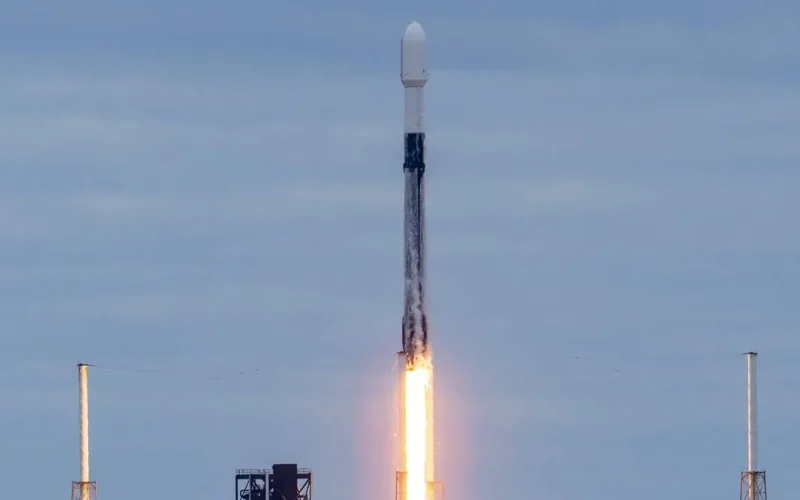ISRO’s GSAT-N2 Satellite Launch by SpaceX: A Turning Point for India’s Space Exploration and the Need for Heavy-Lift Rocket Development
India’s space ambitions reached new heights on November 19, 2024, with the successful launch of the GSAT-N2 communication satellite aboard SpaceX’s Falcon 9 rocket. This historic collaboration between the Indian Space Research Organisation (ISRO) and SpaceX marks a significant milestone in India’s efforts to expand its digital communication infrastructure, particularly in underserved areas. However, the success of this launch highlights a key challenge facing India’s space program—its current inability to launch heavy payloads with indigenous vehicles, which led ISRO to rely on an external partner for this mission.
The GSAT-N2, designed to meet India’s growing demand for high-speed internet and reliable satellite services, weighs 4,700 kg and represents one of the heaviest satellites ISRO has launched. However, this mission also underscores India’s growing dependence on foreign space agencies for heavy-lift rocket capabilities. In this article, we will explore the GSAT-N2’s significance, the reasons behind ISRO’s reliance on SpaceX for its launch, and the broader issue of India’s need for heavy-lift rockets.

The GSAT-N2 Satellite: A Technological Leap for India
The GSAT-N2 satellite is designed to cater to India’s increasing demand for communication and internet services, particularly in rural and remote areas where terrestrial infrastructure is lacking. It is equipped with advanced Ka-band transponders and utilizes a multibeam architecture, which significantly enhances its throughput and coverage. With a total of 32 user beams, including 24 wide spot beams and 8 narrow spot beams, the GSAT-N2 will provide high-speed broadband connectivity across the entire country. This includes improving connectivity in India’s northeastern states, which have traditionally struggled with reliable communication services.
The satellite’s most notable feature is its ability to deliver in-flight connectivity, a service that is becoming increasingly important as air travel continues to grow in India. The GSAT-N2 is expected to play a crucial role in enhancing communication services for both commercial and government sectors, boosting efficiency and ensuring greater accessibility to broadband networks. With a mission life of 14 years, GSAT-N2 will be a long-term asset in India’s space communications portfolio, contributing to the country’s efforts to bridge the digital divide and drive economic growth through digital transformation.
In addition to its broadband capabilities, GSAT-N2 will support critical applications in areas such as telemedicine, disaster management, and e-governance. By providing reliable satellite-based communication, the satellite will help further ISRO’s mission to improve the quality of life for millions of people across the country, especially those in regions that lack access to traditional internet services.

SpaceX’s Role: Why ISRO Turned to the American Giant
While GSAT-N2’s launch was a success, it also highlights an important issue in India’s space program—its reliance on external launch providers for heavy payloads. ISRO has made significant strides in space exploration and satellite deployment, but it has struggled to develop a launch vehicle capable of carrying payloads as heavy as the GSAT-N2. The GSAT-N2 weighs 4,700 kg, which exceeds the capacity of ISRO’s most powerful rocket, the Geosynchronous Satellite Launch Vehicle Mark III (GSLV Mk III), which can carry payloads up to 4,000 kg to geostationary transfer orbit (GTO). As a result, ISRO was unable to launch the satellite with its own rockets and turned to SpaceX, which is known for its powerful and reliable Falcon 9 rockets.
SpaceX’s Falcon 9 rocket is capable of carrying payloads up to 8,300 kg to GTO, making it an ideal candidate for launching satellites like the GSAT-N2. The collaboration between ISRO and SpaceX is part of an increasing trend where countries and space agencies turn to private players for access to advanced space transportation services. This shift is particularly notable as it reflects the growing capabilities of private space companies like SpaceX, which has revolutionized the space industry by making space travel more affordable and accessible.
The partnership between ISRO and SpaceX represents a new phase in India’s space exploration. While ISRO has primarily relied on its own vehicles and the European Ariane rockets for launching its heaviest payloads, the GSAT-N2 launch marks the first time that ISRO has used SpaceX’s Falcon 9 for such a mission. It is also worth noting that this collaboration has taken place in a broader context of increasing demand for launch services, with ISRO unable to meet the growing need for heavy-lift rockets on its own. The GSAT-N2 launch is an acknowledgment of ISRO’s current limitations in this area, despite its growing reputation as a global leader in space exploration.

India’s Struggle with Heavy Payloads: The Gap in ISRO’s Launch Vehicle Capabilities
India has made tremendous progress in the field of space exploration. ISRO has successfully launched a series of satellites for India and other countries, conducted interplanetary missions like the Mars Orbiter Mission (Mangalyaan), and developed world-class satellite systems for communication, weather forecasting, and Earth observation. However, as the payloads required for communication and other satellite services grow heavier and more sophisticated, ISRO has faced increasing difficulty in launching these heavy payloads using its own rockets.
The GSLV Mk III, which is India’s most capable rocket, has a payload capacity of around 4,000 kg to GTO. This capacity falls short of the 4,700 kg GSAT-N2, which is why ISRO had to turn to SpaceX. ISRO’s GSLV rockets have traditionally relied on solid-fuel boosters and cryogenic engines, but even with these advancements, the payload capacity has not reached the level required for larger satellites like GSAT-N2.
In recent years, India has been exploring options for developing more powerful rockets to meet its future payload needs. The GSLV Mk III is expected to undergo further upgrades, and ISRO is also working on the development of the GSLV Mk IV, which will likely feature an even more powerful engine. However, as of now, India’s domestic capabilities are limited when it comes to launching very heavy payloads into orbit.
This situation is not unique to India. Many other space agencies around the world face similar challenges as the size and complexity of modern satellites increase. The global space industry is becoming increasingly reliant on private companies like SpaceX, which have made significant advancements in reusable rocket technology. SpaceX’s Falcon 9, for example, is known for its cost-effectiveness, reusable components, and the ability to carry larger payloads than many government-run space agencies’ rockets.
India’s reliance on private companies for heavy-lift launch services may also be a temporary solution. The need for heavier and more efficient rockets is expected to increase in the coming years as the demand for satellite-based communication, broadband, and other services grows. India’s future in space exploration will depend not only on the continued success of its partnerships with private firms but also on the development of indigenous heavy-lift capabilities.

The Way Forward: Developing Heavy-Lift Capabilities and Self-Reliance in Space
While the GSAT-N2 mission is a success, it also draws attention to the need for India to invest more in the development of its own heavy-lift rockets. The current reliance on private companies like SpaceX for launching larger payloads may limit India’s ability to fully control its space program in the future. Developing a fully indigenous heavy-lift rocket would not only enhance India’s autonomy in space but also position ISRO as a global leader in satellite launches and space technology.
India’s space ambitions are clear: it wants to be a major player in satellite communication, space exploration, and technology development. To achieve these goals, it is imperative that ISRO invests in advancing its rocket technology. The GSLV Mk IV, along with other next-generation launch vehicles, must be developed and tested as quickly as possible to ensure that India can continue to meet the growing demand for space-based services without relying on external partners.
Moreover, India must continue to innovate and collaborate with private companies to enhance the capabilities of its space sector. By encouraging collaboration between government agencies and private firms, India can build a robust space industry that can compete on the global stage.
Conclusion
The successful launch of GSAT-N2 aboard SpaceX’s Falcon 9 rocket is a significant achievement for ISRO and for India’s space ambitions. However, it also highlights a critical challenge: the lack of heavy-lift launch vehicles in India’s space program. While collaborations with private companies like SpaceX are essential in the short term, India must focus on developing its own heavy-lift rockets to ensure its space program’s future growth and self-sufficiency. The GSAT-N2 mission is a testament to ISRO’s resilience and adaptability, but the road ahead requires continued investment, innovation, and the development of indigenous technologies. Only then will India truly be able to realize its space exploration goals and position itself as a global leader in space technology.









